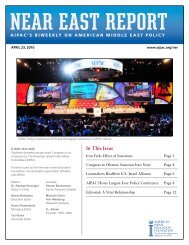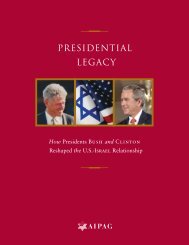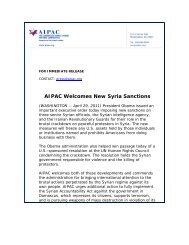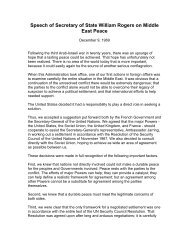2013 Briefing Book - Print Version - Aipac
2013 Briefing Book - Print Version - Aipac
2013 Briefing Book - Print Version - Aipac
Create successful ePaper yourself
Turn your PDF publications into a flip-book with our unique Google optimized e-Paper software.
IRAN<br />
UNDERMINE AMERICA’S CREDIBILITY<br />
For the past two decades, the United States has proclaimed that it is unacceptable for Iran to<br />
acquire nuclear weapons and has sought to prevent that from occurring. If the United States fails<br />
to prevent Iran from acquiring a nuclear weapons capability, America’s credibility in the eyes of its<br />
allies in the region—and around the world—would be undermined.<br />
Iran Pressing Ahead With Its Nuclear Weapons Pursuit<br />
These dangerous scenarios are moving closer to reality, as Iran continues to ignore the repeated<br />
demands of the U.N. Security Council to suspend its nuclear activities. For more than 25 years,<br />
Iran has pursued a path to a nuclear weapons capability, constructing a secret program in<br />
violation of the Nuclear Non-Proliferation Treaty (NPT).<br />
Iran has focused its nuclear efforts on enriching uranium, a key step in producing fissile material<br />
for the core of a nuclear weapon. Low levels of enriched uranium generate power, while highly<br />
enriched uranium (HEU) is used to make bombs. As of November 2012, Iran had produced nearly<br />
17,000 pounds of low-enriched uranium (LEU). If further enriched to a weapons-grade level, the<br />
uranium would be enough to produce six to seven nuclear weapons.<br />
Iran has also begun the process of converting its LEU into uranium enriched to the 20 percent<br />
level. This level represents 85-90 percent of the effort needed to produce weapons-grade fuel. As<br />
of November 2012, Iran had produced more than 500 pounds of this higher enriched uranium.<br />
This amount is more than enough—if further enriched to weapons grade—to fuel a nuclear bomb.<br />
To date, most of Iran’s enrichment activity has taken place at the Natanz facility. In September<br />
2009, the United States disclosed that Iran was constructing a secret uranium enrichment facility<br />
located deep in a mountain on an Islamic Revolutionary Guard Corps (IRGC) base near Qom.<br />
The size of the facility is insufficient to produce needed fuel for a nuclear power reactor, but ideal<br />
to produce weapons grade uranium.<br />
In the fall of 2012, Iran completed the installation of nearly 2,800 centrifuges at the facility. Once<br />
fully operational, the site could allow Iran to triple its output of higher enriched uranium.<br />
Iran claims that it needs this uranium for a research reactor in Tehran that produces radioactive<br />
isotopes for medical procedures. However, Iran rejected a proposal backed by the United States,<br />
France and Russia that would send a portion of Iran’s LEU outside the country in return for the<br />
medical-grade fuel. Under the proposal, Iran would have been able to meet its medical needs,<br />
122








